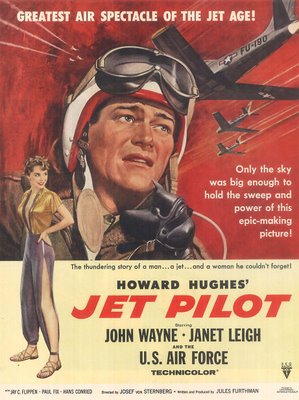

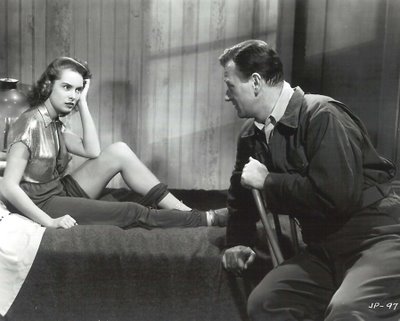
Some "Bad" John Waynes On DVD --- Part 2
Jet Pilot’s a handy receptacle for critical derision --- the butt of a hundred old movie jokes, forever tied to a whipping post along with The Conqueror. It’s pure reflex that cites these as John Wayne’s all-time worst. For years, they were impossible to see. During Howard Hughes’ lifetime, he kept them out of circulation. A few prints of Jet Pilot traveled among collectors, but it would be well into the eighties before either would see daylight on TV or video. Having it available on DVD may not rehabilitate its tarnished reputation, but at least we can enjoy what is at times a visually stunning show, featuring one of the most breathtaking glamour turns on vintage view. Jet Pilot was meant to be the next Hell’s Angels. Howard Hughes wanted to go the old picture one better by staging dogfights with jets instead of bi-planes. He began in 1949, and obsessed over it for the next eight years. By the time Universal released Jet Pilot in September 1957, it was an old movie, with older airplanes. Even the biggest campaign in U-I’s history couldn’t save Jet Pilot from critical drubbing and disastrous word-of-mouth. In the end, Hughes took back the negative and spent most of the next two decades watching it by himself on a tabletop projector. It ended up being the most expensive home movie ever made.
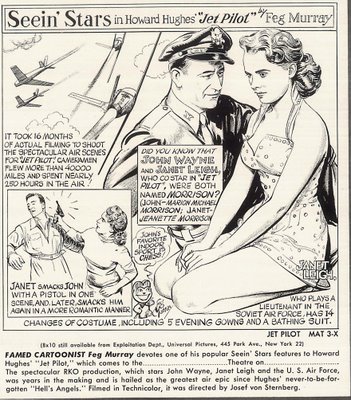
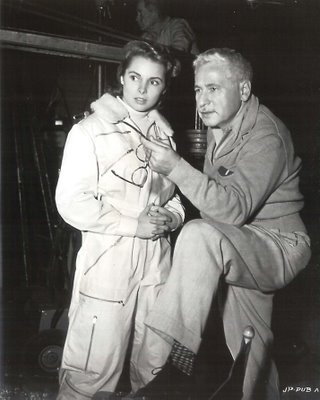
Robert Mitchum was originally set for the lead in Jet Pilot. Wayne stepped in after signing a multi-picture deal with Hughes. They were chums off-screen. Howard wanted to be Duke, and Wayne couldn’t help being impressed by a man so powerful he could seemingly make clocks stop at will. Shooting began on Halloween 1949 under the direction of cast-off tyro director Josef Von Sternberg, whose comeback was breathlessly reported by lifelong acolyte Herman G. Weinberg in The New York Times. My films were protests against other films at the time, said the master craftsman after eight years in cinematic Siberia, and worship-the-ground-he-walked-on Weinberg was tactful re Jo's on-set tyranny and abuses --- but even this Bligh with a megaphone was no match for Hughes’ controlling ways. Sternberg (shown here with Janet Leigh and on the crane directing a dance sequence) wasn’t involved with the flying shots in any case. Multiple second units shot those at fourteen air bases from Alaska to Florida. Sixteen initial months were spent on aerial stuff, and there is reason to believe Hughes continued gathering jet footage beyond even that. MGM head Dore Schary had loaned Janet Leigh to co-star, but he never dreamed this project would drag so far into a next decade. Schary would later recall Hughes’ request for further services --- seems he wanted retakes on Jet Pilot --- three years after principal photography had ended. I have had my bellyfull, said Hughes to Schary shortly before the show was finally released, and indeed this would be his final project before the cameras.
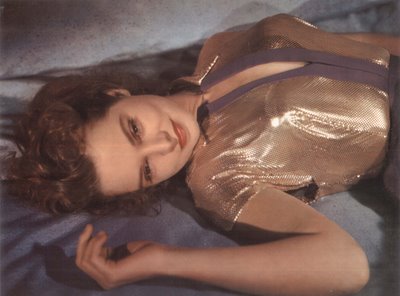
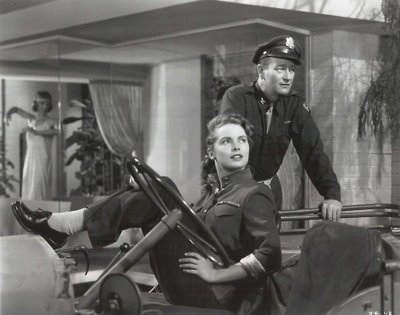
Anyone else would have wanted Jet Pilot wrapped A.S.A.P., seeing as how the jet fad couldn’t last forever, but Hughes dawdled while Chain Lightning, Breaking The Sound Barrier, and other supersonics took to skies. Despite his occasional updating of the flight footage (which, of course, no one had seen), similar projects flew away with Jet Pilot’s potential audience. Press releases and gossip continued to appear as the fifties wore on, but Hughes wouldn’t let it go. Sternberg had long since been let go --- Wayne oft expressed a desire to "kill the sonofabitch." --- pinch-hit directors Nicholas Ray and Jules Furthman (who’d also been associate producer and writer) were brought aboard for the seemingly endless retakes. When Universal finally took custody (Hughes having sold RKO in the meantime), they wisely opted for saturation release with a whopping 400 prints opening day-and-date (the better to get patron’s money before a stench got out). Commenting on years of press coverage now in the morgues, Jet Pilot's pressbook openly inquired of showmen, How much of this penetration has been retained --- How much of it has faded with time? Harrison’s Reports said Universal was spending unprecedented dollars on a new campaign. I wonder how much of this Hughes footed. Critics were merciless, as expected, commenting on how "youthful" the two stars looked in a now ancient vehicle. Others observed that the planes were "obsolete and out of date" (as if they’d know the difference between a B-45 and a dill pickle). What may have wounded Hughes most were harsh comparisons between Jet Pilot and Paramount’s recent Strategic Air Command, which had the benefit of up-to-the-minute air technology and Vistavision in the bargain. Panoramic projection had become a must since bygone days when Jet Pilot was in production, but U-I solved that by going with ersatz wide prints that played havoc with Sternberg’s elegant compositions. Later 16mm prints and videos were full-frame as intended, but Universal’s new DVD goes back to 1.85. They could at least have offered it both ways.
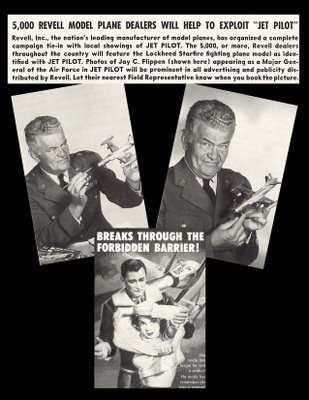
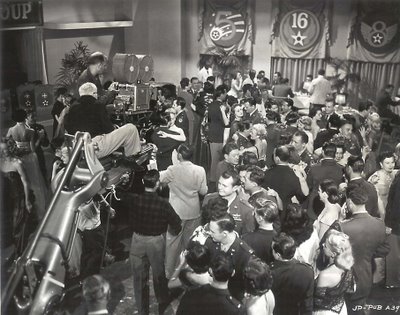
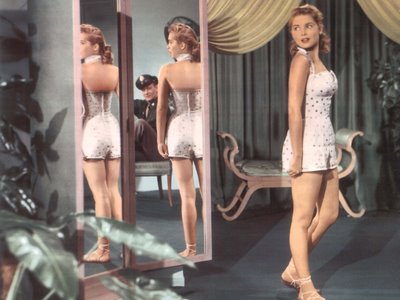
Sixties and thereafter critics speak of Jet Pilot in terms of "cold war hysteria." "Piquant Howard Hughes sex farce" is how I prefer to think of it. I’m betting he got together with Howard Hawks on some of the gags and situations in this show. More than once, I was reminded of The Thing (which RKO would have been shooting at the same time). Janet Leigh’s renegade Russian flyer might just as easily have touched down at Captain Hendrys airbase, leaving that titular super-carrot to bedevil John Wayne and Paul Fix. Imagine Kenneth Tobey engaged in saucy repartee with Janet! As it is, there’s a scene in both pictures where guys enter a room from the frigid outside, being admonished by those within to "Close the door!" He may have been the biggest yank-off in town, but Jo Von Sternberg knew a thing or three about photography and direction. Everything he did for Dietrich in the thirties is surpassed here --- only this time it’s in color. Howard and Jo are a great team in Jet Pilot, whatever you may have heard to the contrary. For every blandishment he got about Jane Russell, this is where Hughes really delivered on the sex. Each close-up of Janet Leigh is a stunner. Never mind cold war hysterics. Buy it just to look at her. Jet Pilot is too stupid and raunchy for most critical sensibilities, dialogue reminiscent of Playboy Party Jokes, and all the more unsettling with John Wayne delivering it. You’d expect him to eventually chuck the love stuff and get on with mopping up commies, but the sex pursuit remains front and center throughout. Hughes saw nothing else as interesting, and neither did I. It is celebrated airborne scenes that are the drag. None of numerous jets get in a fight, flying instead to no good purpose. I never understood their goal, other than to look for fluffy clouds to serve as arresting backdrop. Universal's DVD, among its group of Wayne vehicles in a box set, looks fine.
3 Comments:
I only saw Jet Pilot once. My memory is that every time Janet Leigh took a big breath of air, to put it diplomatically, you would hear the sound of jets overhead.
Excellent evaluation--BUT--having run this picture in my home theatre, I will say that one has to view it with the attitude that you are a kid approaching puberty at the show in the 1950s and love the combination of John Wayne, fighter planes and a sexy woman--all in technicolor on the big screen!
It bears all the hallmarks of Howard Hughes schmaltz, so if you don't like sexist remarks, broad drama, unrealistic and incredible situations, you won't like "Jet Pilot"
I got a big boot out of putting myself in John Wayne's shoes in this picture--he scores across the board--in his heroic actions as well as winning a freshly-made-over-at-his-disposal sexy woman!
As a former 35mm film collector, I recall there were many prints of "Jet Pilot" around the collectors market in the 1980s and 1990s. They were all "Superscope" which was RKOs entry in the widescreen craze of the 50s. Superscope was approximately 1:85 ratio, which was narrower than standard "scope", so the DVD release is indeed from the theatrical distribution. I do agree that due to the 1949 original shooting, that the picture was originally full frame 1:33, and later converted to Superscope to cash in on widescreen presentation, which must have played havoc with the original composition of the picture!
Post a Comment
<< Home